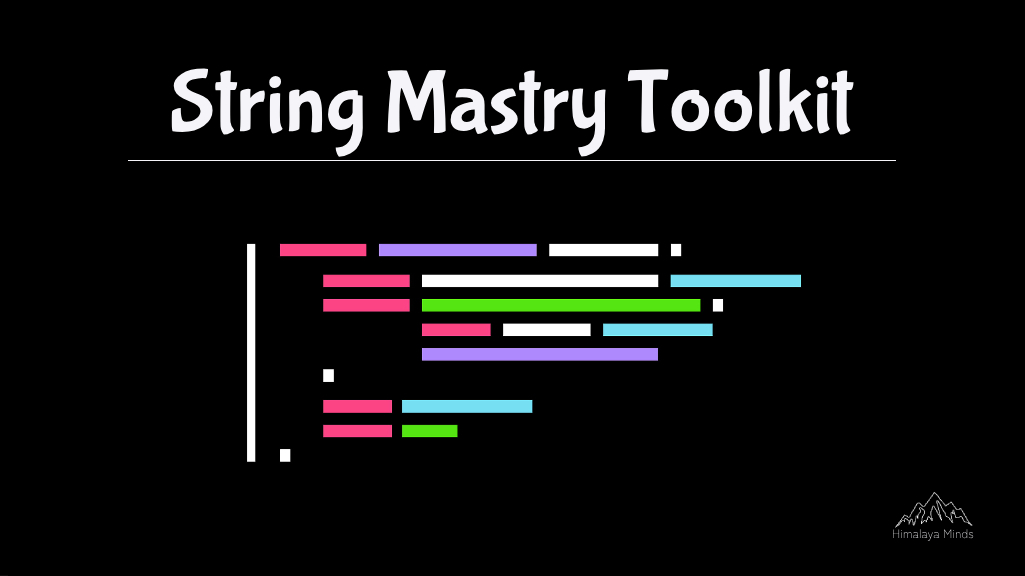A Comprehensive Toolbox for Mastery in String Operations Across Programming Paradigms 🚀🔍
Welcome to String Mastery Toolkit, an open-source haven designed to empower beginner programmers on their journey to mastering string operations. This repository serves as a learning hub, offering a wide array of resources, examples, and hands-on exercises to enhance your proficiency in manipulating strings.
🚀 #TextProcessing #TextProcessing #ProgrammingSkills #DevTools #DevHacks #TechTips #OpenSource
- Basics to Advanced Techniques : Explore a carefully curated set of tutorials covering fundamental string operations and progressing to more advanced techniques.
- Interactive Examples : Dive into interactive examples and coding challenges to gain hands-on experience, reinforcing your understanding of string manipulation concepts.
- Cross-Language Support: Tailored examples and best practices for string manipulation in popular programming languages, ensuring relevance across different tech stacks.
- Documentation Galore: Extensive documentation providing clear explanations, use cases, and best practices for each string operation method, making learning accessible for all skill levels.
- Collaborative Learning: Engage with the vibrant community through discussions, Q&A sessions, and collaborative projects to foster a supportive learning environment.
In programming, a string is a sequence of characters, typically used to represent text. A character can be any individual letter, number, symbol, or whitespace. Strings are a fundamental data type in most programming languages and are used to store and manipulate textual data.
-
Text Representation: Strings are used to represent and manipulate textual information. This includes everything from simple words and sentences to more complex data like file paths, URLs, and program source code.
-
Input and Output: Strings are commonly used to handle input and output operations. For example, when reading data from a user via a keyboard or displaying information to the user on the screen.
-
Data Processing: Many algorithms and operations involve processing and manipulating strings. Tasks such as searching, sorting, parsing, and modifying textual data rely heavily on string manipulation.
-
Text Processing and Analysis: In applications such as natural language processing, data mining, and text analysis, strings play a crucial role in handling and processing textual information.
-
Communication: Strings are often used for communication between different parts of a program or between different programs. For example, when sending data over a network or storing information in a database.
In most programming languages, strings are represented as a sequence of characters enclosed within quotation marks (single or double). For example, in Python:
my_string = "Hello, World!"You can perform various operations on strings, such as concatenation, slicing, searching, and more, depending on the programming language. The ability to work with strings is a fundamental skill for programmers working with any type of application that involves handling and manipulating textual data.
In programming, a string is a sequence of characters, and various programming languages provide string methods or functions to manipulate and work with strings effectively. Here's a general overview of common string methods that you might encounter:
-
Concatenation:
- Description: Combining two or more strings into a single string.
- Example (in JavaScript):
let fullName = firstName + " " + lastName;
-
Length:
- Description: Determining the number of characters in a string.
- Example (in Python):
length = len(myString);
-
Substring:
- Description: Extracting a portion of a string.
- Example (in Java):
String sub = myString.substring(startIndex, endIndex);
-
Search/Substring Search:
- Description: Finding the position of a substring within a string.
- Example (in C#):
int position = myString.IndexOf("searchString");
-
Case Conversion:
- Description: Changing the case of characters in a string.
- Example (in Python):
upperString = myString.upper();
-
Trimming:
- Description: Removing leading and trailing whitespaces from a string.
- Example (in JavaScript):
trimmedString = myString.trim();
-
Replacement:
- Description: Replacing occurrences of a substring with another substring.
- Example (in Python):
newString = myString.replace("old", "new");
-
Splitting:
- Description: Breaking a string into an array of substrings based on a delimiter.
- Example (in Java):
String[] parts = myString.split("\\s+");
-
Comparison:
- Description: Comparing two strings for equality or determining their order.
- Example (in C++):
if (str1 == str2) { /* Do something */ }
-
Formatting:
- Description: Creating formatted strings with placeholders.
- Example (in Python):
formattedString = "Hello, {}!".format(name);
These are just a few examples, and the availability of these methods may vary between programming languages. It's essential to refer to the documentation of the specific programming language you're working with to understand and use its string manipulation methods effectively.
We welcome contributions from all skill levels! Whether you're a beginner eager to share your learning journey or an experienced developer adding more advanced examples, your contributions are valuable. Check out our contribution guidelines to get started.
- Frontend: Markdown for documentation, interactive coding examples using CodeSandbox.
- Backend: Node.js for server-side scripting (used for backend examples).
- Collaboration: GitHub Discussions for community interactions.
StringMasteryToolkit is released under the MIT License, encouraging collaboration and widespread use. See the LICENSE file for details.
Ready to unravel the secrets of string manipulation? Join us on this exciting learning adventure with StringMasteryToolkit!
Feel free to customize the content further based on your preferences and the actual structure of your repository.
